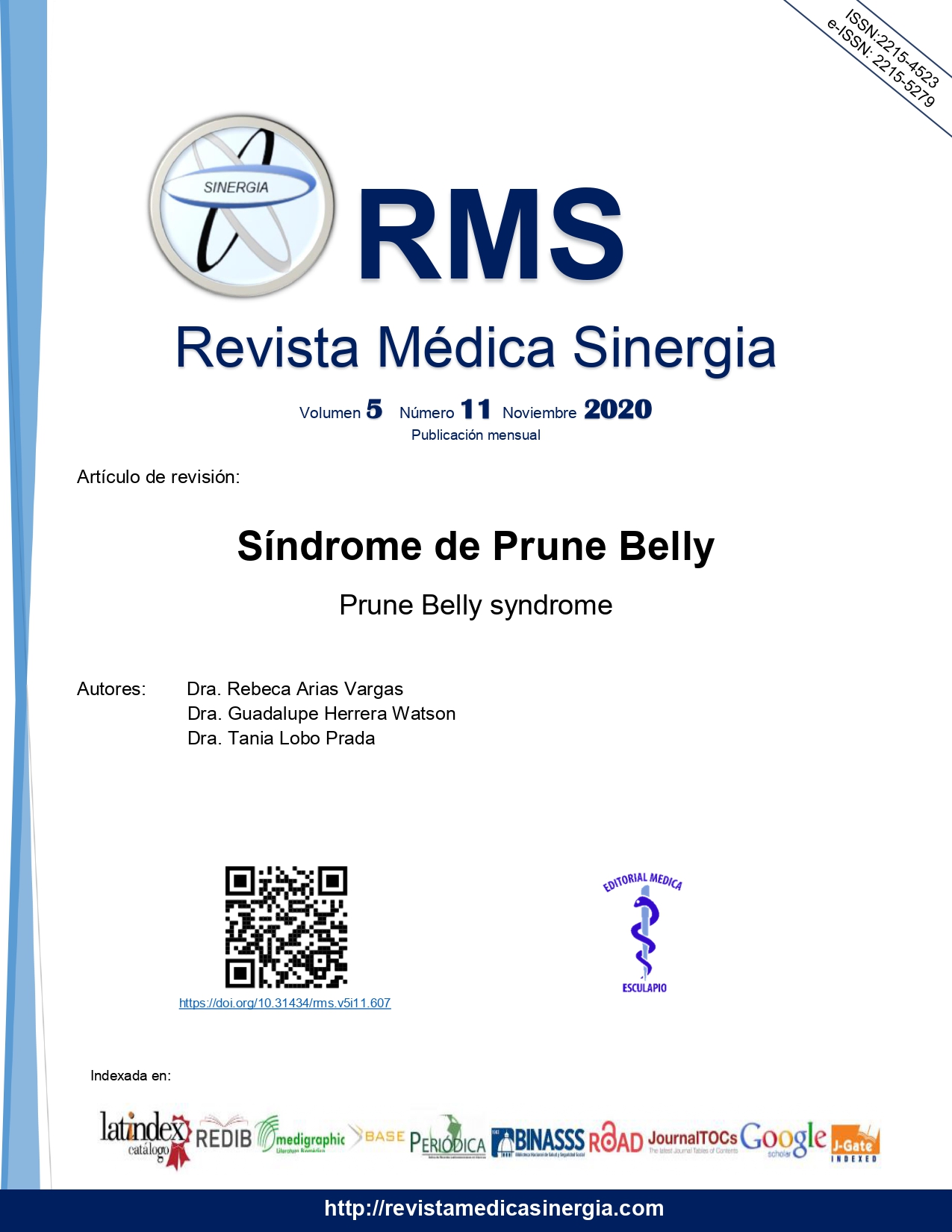Resumen
El síndrome de Prune Belly o síndrome de Eagle Barret es una malformación congénita rara de etiología desconocida, caracterizada por la triada: hipoplasia de la pared muscular abdominal, criptorquidia y anomalías del tracto urinario. El cuadro clínico que desencadena es variable, dependiendo sobre todo del grado de alteración del sistema urinario y compromiso renal. La detección del síndrome de Prune Belly, en su mayoría, se realiza ya sea por medio de ultrasonografía antenatal o en el periodo neonatal. Su tratamiento suele ser conservador, con excepciones donde es necesaria la intervención quirúrgica, la cual depende de la gravedad de los síntomas, y abarca desde procedimientos modestos hasta otros más extensos.
Palabras clave
Citas
Achour R, Bennour W, Ksibi I, Cheour M, Hamila T, Hmid B et al. Prune belly syndrome: Approaches to its diagnosis and management. Intractable Rare Dis Res. 2018;7(4):271-4. https://doi.org/10.5582/irdr.2018.01094
Arlen A, Nawaf C, Kirsch A. Prune belly syndrome: current perspectives. Pediatr Heal Med Ther. 2019. 10(1):75-81. https://doi.org/10.2147/PHMT.S188014
Ferrer R, Vásquez R, Madiedo D. Síndrome de Prune Belly: Revisión Bibliográfica. Multimed. 2016; 20(4):831-8.
Alkhamis W, Abdulghani S, Altaki A. Challenging diagnosis of Prune belly syndrome antenatally: A case report. J Med Case Rep. 2019;13(1):1-6. https://doi.org/10.1186/s13256-019-2120-x
Joseph D. Prune Belly Syndrome. In: Barakat A, Rushton G (eds). Congenital Anomalies of the Kidney and Urinary Tract. 1st ed. Switzerland: Springer International Publishing; 2016. p. 197-213. https://doi.org/10.1007/978-3-319-29219-9_10
Samal S, Rathod S. Prune Belly syndrome: A rare case report. J Nat Sci Biol Med. 2015;6(1):255. https://doi.org/10.4103/0976-9668.149218
Abdelmoneim K, Eltigani Ali, Safaa M, Huda M. Prune belly syndrome: A report of 15 cases from Sudan. Sudan J Paediatr. 2017; 17 (1): 42-48. https://doi.org/10.24911/SJP.2017.2.5
Solarin A, Disu E, Gbelee H, Animashaun A, Aremu O, Ogbuokiri E, et al. Three Cases of Prune Belly Syndrome at the Lagos State University Teaching Hospital, Ikeja. Saudi J Kidney Dis Transpl. 2018;29(1):178-184.https://doi.org/10.4103/1319-2442.225190
Staatz G, Rascher W. Imaging in Prune Belly Syndrome and Other Syndromes Affecting the Urogenital Tract. In: Riccabona M (eds). Pediatric Urogenital Radiology. 1st ed. Switzerland: Springer International Publishing; 2018. p. 481-490. https://doi.org/10.1007/978-3-319-39202-8_27
Boghossian NS, Sicko RJ, Giannakou A, Dimopoulos A, Caggana M, Tsai MY et al. Rare copy number variants identified in Prune belly syndrome. Eur J Med Genet. 2018;61(3):145-51. https://doi.org/10.1016/j.ejmg.2017.11.008
Keet K, Michael B, Tubbs S. Prune-belly syndrome in Africa: An analysis and systematic review of cases, etiology, treatment, and outcomes. J Clin Urol. 2019. https://doi.org/10.1177/2051415820903196
Cornel A, Duicu C, Delean D, Bulata B, Starcea M. Long term follow-up in a patient with prune-belly syndrome - a care compliant case report. Medicine. 2019; 98(33): e16745. https://doi.org/10.1097/MD.0000000000016745
Brewer F, Harper I. Prune-Belly Syndrome. In Copel J Obstetric Imaging: Fetal Diagnosis. 2nd ed. Philadelphia: Elsevier Health Sciences; 2017. p. 574-576. https://doi.org/10.1016/B978-0-323-44548-1.00139-X
Demisse A, Berhanu A, Tadesse T. Unusual presentation of Prune belly syndrome: a case report. J Med Case Rep. 2017; 11:337. https://doi.org/10.1186/s13256-017-1487-9
Gupta A, Sehgal R, Vasdev N, Mehta S, Sain P. Antenatal Diagnosis of Prune Belly Syndrome. J. Fetal Med. 2016. https://doi.org/10.1007/s40556-016-0085-z
Chhabra R, Awan A, Stapleton C, Cavalleri G, Conlon P. Clinical manifestations of Prune belly síndrome. Clin Med. 2016; 16(3). https://doi.org/10.7861/clinmedicine.16-3-s5
Wong DG, Arevalo MK, Passoni NM, Iqbal NS, Jascur T, Kern AJ, et al. Phenotypic severity scoring system and categorisation for Prune belly syndrome: application to a pilot cohort of 50 living patients. BJU Int. 2019;123(1):130-9. https://doi.org/10.1111/bju.14524
White J, Sheth K, Bilgutay A, Roth D, Austin P, Gonzales E et al. Vesicoamniotic Shunting Improves Outcomes in a Subset of Prune Belly Syndrome Patients at a Single Tertiary Center. Front Pediatr. 2018; 6:180. https://doi.org/10.3389/fped.2018.00180
Selvi I, Baydilli N, Akınsal E. A rare case: Congenital Megalourethra in prune belly syndrome. Arch Case Rep. 2018; 2: 001-003. https://doi.org/10.29328/journal.acr.1001005
Redondo Y, Ruiz O, Ramírez R, Venegas R. Síndrome Prune Belly: sobrevida de un paciente con insuficiencia Renal. Pediatr. 2017; 50(3):78-81. https://doi.org/10.14295/pediatr.v50i3.69

Esta obra está bajo una licencia internacional Creative Commons Atribución-NoComercial 4.0.
Derechos de autor 2020 Array


